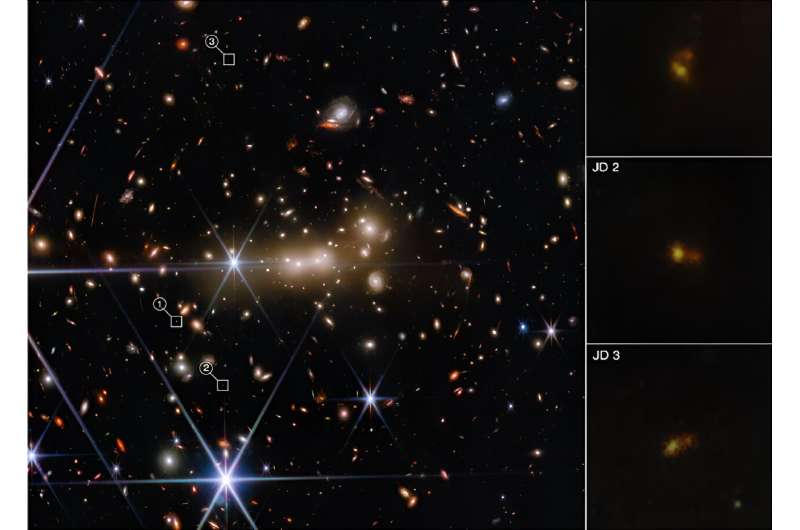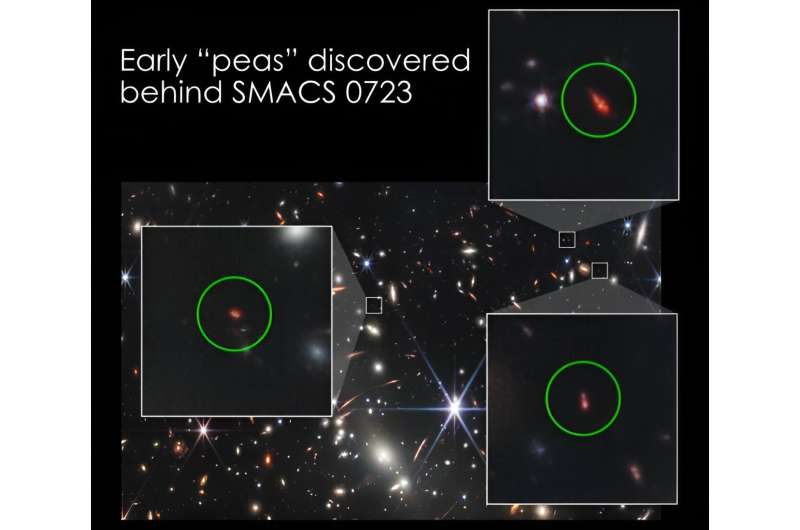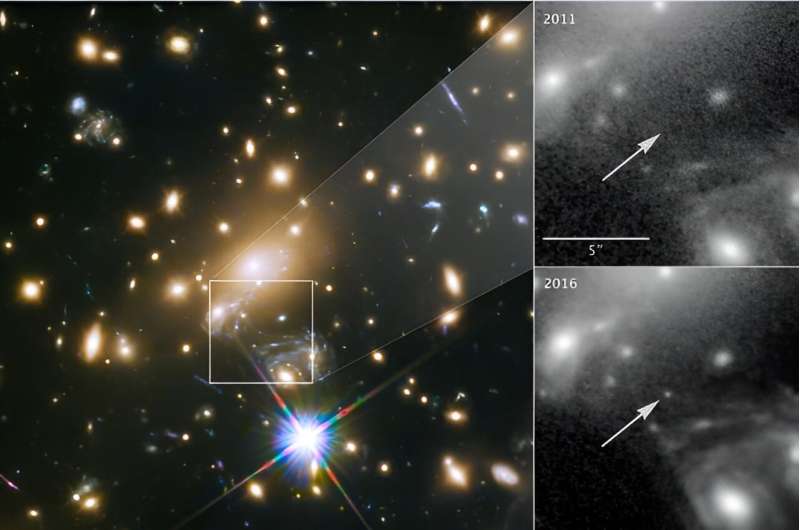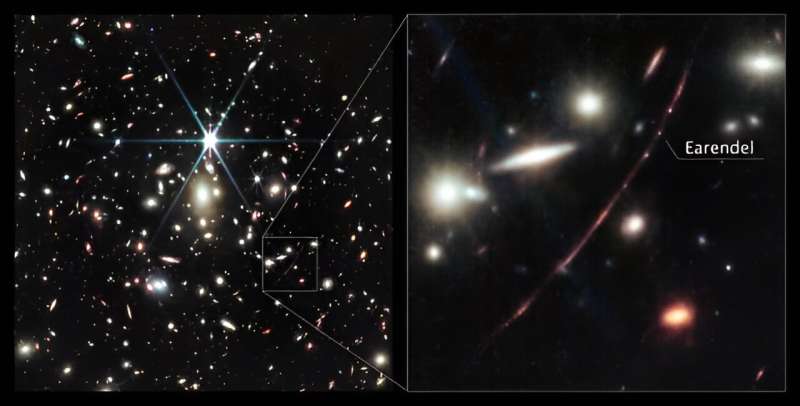This article has been reviewed according to Science X's editorial process and policies. Editors have highlighted the following attributes while ensuring the content's credibility:
fact-checked
preprint
trusted source
proofread
JWST plucks one single star out of a galaxy seen 12.5 billion years ago

After years of build-up and anticipation, the James Webb Space Telescope finally launched into orbit on December 25th, 2021 (what a Christmas present, huh?). Since then, the stunning images and data it has returned have proven beyond a doubt that it was the best Christmas present ever. After its first year of operations, the JWST has lived up to one of its primary objectives: to observe the first stars and galaxies that populated the universe. The next-generation observatory has accomplished that by setting new distance records and revealing galaxies that existed less than 1 billion years after the Big Bang.
These studies are essential to charting the evolution of the cosmos and resolving issues with our cosmological models, like the Hubble tension and the mysteries of dark matter and dark energy. Well, hang onto your hats because things have reached a new level of awesome! In a recent study, an international team of scientists isolated a well-magnified star candidate in a galaxy that appears as it was almost 12.5 billion years ago. The detection of a star that existed when the universe was only ~1.2 billion years old showcases the abilities of the JWST and offers a preview of what's to come. The study is available on the arXiv preprint server.
The research was led by Lukas J. Furtak, a postdoctoral student of experimental astrophysics at the Ben-Gurion University of the Negev. The international team he led consisted of astronomers and astrophysicists from the Cosmic Dawn Center (DAWN), the Space Telescope Science Institute (STScI), the Association of Universities for Research in Astronomy (AURA), the Spanish National Research Council (CSIS), the Center for Extragalactic Astronomy, the Racah Institute of Physics, the Harvard-Smithsonian Center for Astrophysics (CfA), the Observational Cosmology Lab at NASA's Goddard Space Flight Center, and more.
Observations by Hubble and JWST of some of the earliest galaxies in the universe have provided a wealth of information that challenged and confirmed prevailing models of cosmological evolution. Unfortunately, as the authors indicated in their study, directly observing individual stars at these distances is impossible since they are too dim relative to their surrounding galaxies. However, scientists have demonstrated that stars can be observed using gravitational lensing, a technique where a massive object in the foreground will amplify light from a more distant object.

This effect, predicted by Einstein's Theory of General Relativity, occurs when the gravitational force of massive objects alters the curvature of spacetime around them. In recent years, this technique has allowed astronomers to identify several dozen stars in strong lensing star cluster fields, and the JWST has detected several already. For the sake of their study, the team consulted images obtained by Webb's Near-Infrared Camera (NIRCam), which captured the galaxy cluster MACS0647 during its first year of operations as part of the Cycle 1 General Observers (GO) program 1433.
As Furtak told Universe Today via email, this represented a major accomplishment, as lensed studies traditionally focus on high-redshift galaxies:
"The study of individual lensed stars at cosmological distances is a relatively new field that has gained interest in recent years thanks to the phenomenal capacities of the Hubble and James Webb Space Telescopes. Individual stars can normally only be observed in our Galaxy and its immediate neighbors while at larger cosmological distances we only see whole galaxies.
"However, the gravitational lensing effect, where massive objects such as galaxy clusters deflect the light from background sources and magnify it, can change this if a single star in a lensed background galaxy happens to cross the so-called critical line which is a region where the gravitational magnification reaches extreme values. If the alignment is right, this then enables us to observe single stars in distant galaxies."

The gravity of this massive cluster produces a powerful lens that has already been used to identify the triple-lensed JD galaxy, which has a redshift value of z=11. This corresponds to an apparent distance of 13.4 billion light-years ago, which means it appears today as it did when the universe was less than 500 million years old. Using this same lensing galaxy, the team obtained spectra from an individual star at z=4.76 (MACS0647-star-1)—at an apparent distance of about 12.35 billion years ago—and analyzed it to derive the star's properties.
The star was first detected in 2022 using data from Webb's NIRCam, which was reported on in a paper by Dr. Ashish Meena of Ben-Gurion University (a colleague and co-author on this latest paper. Said Furtak:
"[MACS0647-star-1] was identified as such based on its position in a strongly lensed and distorted background galaxy very close or even on top of the critical line, i.e., in a region where the gravitational lensing magnification reaches extreme values. Note that a fainter second star was also detected in the same study, MACS0647-star-2. Based on the photometry in multiple broad-band filters, MACS0647-star-1 was identified as a candidate B-type supergiant star of surface temperature ~10,000K."
A few months later, Furtak and his team obtained the MACS0647-star-1 spectra using Webb's Near-Infrared Spectrometer (NIRSpec) as part of a larger campaign targeting the whole lensing cluster. The spectra allowed them to precisely measure the redshift to MACSO647-star-1, from which they derived distance estimates that showed the star existed when the universe was just 1.2 billion years old. As Furtak added, they also found that the spectrum provided a more complex picture than the previous photometric data:

"While the photometric measurement from the imaging was consistent with a single B-type supergiant star, [but] with the spectrum we now see, we must be either looking at two stars—one B-type and one colder F-type—or at a hot B-type star whose light is reddened by dust somewhere along the line of sight. The latter explanation is the more probable one, though. That being said, with the current spectrum—i.e., 1.8h integration time and NIRSpec-prism mode, which has a relatively low resolution—we cannot completely rule out the possibility that this is not actually a whole star-cluster instead of a single star either (i.e., a globular-cluster type object, very dense old stellar population)."
To get a better idea of what Webb revealed, follow-up observations of the MACS0647 lensing galaxy are needed. Specifically, Furtak indicated the need for much deeper spectra and much higher spectral resolution to measure absorption lines more clearly. Regardless, these findings are likely to become commonplace soon as Webb continues to study stars and galaxies that existed during the early universe. To date, several lensed stars at cosmological distances have been observed by Hubble, the first (Icarus) being spotted in 2018 by Hubble, while the latest (Earendel) was detected in 2022.
Based on what Webb has revealed in just its first year of observations, Furtak anticipates that the JWST will find lensed stars at a rate of one per galaxy cluster observed. It has already detected several lensed stars, including MACS0647-star-1, which is the second furthest observed to date. This, said Furtak, offers a tantalizing preview of what lies in store:
"This study definitely shows that JWST has the instrumental capacity to not only detect lensed stars in imaging campaigns but to also obtain their spectra with NIRSpec. This is the second spectrum of a lensed star ever obtained and the first space-based one with JWST. For example, a spectrum for the most distant star Earendel, has also recently been taken and will probably be published soon. In future observation campaigns, we can systematically follow up NIRCam-detected lensed stars, if they are persistent sources, with NIRSpec spectroscopy in order to derive their properties.
"This study is also based on relatively short JWST exposure times of ~2h, whereas JWST is perfectly capable of reaching much higher signal-to-noise ratios through longer exposure times which means that future NIRSpec observations might well be able to detect absorption features in lensed stars at least in the brightest ones. Note that this would also be a compelling science case for the upcoming 30m-class telescopes like ESOs ELT, which will be able to reach similar sensitivities and resolutions as JWST, though be it at slightly lower wavelengths."
More information: Lukas J. Furtak et al, Reaching for the stars—JWST/NIRSpec spectroscopy of a lensed star candidate at $z=4.76$, arXiv (2023). DOI: 10.48550/arxiv.2308.00042
Journal information: arXiv
Provided by Universe Today





















